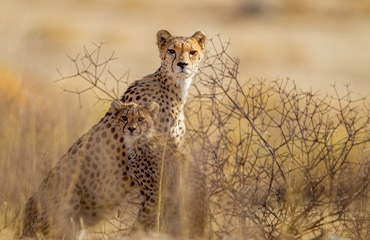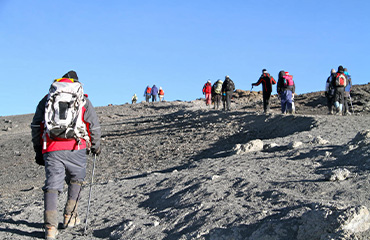The highest point of Mount Kilimanjaro is Uhuru Peak, which stands at an elevation of 5,895 meters (19,341 feet) above sea level.
Mount Kilimanjaro Climbing FAQs: Your Ultimate Guide
Mount Kilimanjaro
What is the highest point of Mount Kilimanjaro?
How many routes are there to climb Mount Kilimanjaro?
Mount Kilimanjaro offers several climbing routes, with the most popular ones being the Marangu, Machame, Lemosho, Rongai, and Northern Circuit routes. Each route varies in terms of difficulty, duration, and scenery.
What type of climate can be found on Mount Kilimanjaro?
Mount Kilimanjaro features diverse climate zones, ranging from tropical at the base to alpine and arctic at the summit. Climbers can experience everything from lush rainforests to icy glaciers during their ascent.
Safety
How safe is it to climb Mount Kilimanjaro?
Climbing Mount Kilimanjaro is generally safe with proper preparation, experienced guides, and adherence to safety protocols. Our team prioritizes safety by providing trained guides, emergency equipment, and evacuation procedures in case of emergencies.
How can I ensure safety before climbing Mount Kilimanjaro?
Before embarking on the climb, ensure you undergo a medical check-up, train physically, and acclimatize to high altitudes. It's crucial to have suitable gear, follow your guide's instructions, and stay hydrated to mitigate risks
What are the common safety risks while climbing Mount Kilimanjaro?
Common safety risks include altitude sickness, extreme weather conditions, and physical exertion. Our team minimizes these risks by providing experienced guides, necessary equipment, and implementing safety measures throughout the journey.
Equipment
What essential equipment do I need for climbing Mount Kilimanjaro?
Essential equipment for climbing Mount Kilimanjaro includes proper hiking boots, layered clothing for varying temperatures, a warm sleeping bag, a headlamp, trekking poles, and personal toiletries. It's crucial to pack light yet adequately for the trek.
Can I rent equipment for Mount Kilimanjaro
Yes, local outfitters and tour operators offer equipment rental services for items like sleeping bags, jackets, and hiking poles. However, bringing personal items for comfort and hygiene is recommended during the climb.
How do I choose the right gear for climbing Mount Kilimanjaro?
When selecting gear, prioritize quality, durability, and suitability for high-altitude trekking. Research gear recommendations, consult with experienced climbers, and ensure your equipment is suitable for the specific route and weather conditions.
Food and Water
What meals are provided during the Mount Kilimanjaro climb?
Meals include a variety of nutritious dishes such as soups, pasta, rice, vegetables, and fresh fruits. Experienced cooks prepare meals to fuel climbers for the trek ahead, catering to dietary preferences and requirements.
How is water availability managed during the Mount Kilimanjaro climb?
Our team ensures an adequate supply of safe drinking water throughout the climb. We provide filtered or treated water at designated points along the route, prioritizing hydration to support climbers' health and well-being.
Are special dietary requirements accommodated during the Mount Kilimanjaro climb?
Yes, we accommodate special dietary requirements such as vegetarian, vegan, gluten-free, and allergies. Prior communication regarding dietary needs allows us to tailor meals accordingly, ensuring all climbers are adequately nourished during the ascent.
Route Options
What are the different route options for climbing Mount Kilimanjaro?
Mount Kilimanjaro offers several route options, each with unique characteristics and difficulty levels. Popular routes include the Marangu, Machame, Lemosho, Rongai, and Northern Circuit routes, catering to different preferences and fitness levels.
Which route is recommended for first-time climbers of Mount Kilimanjaro?
The Marangu route, also known as the "Coca-Cola" route, is often recommended for first-time climbers due to its gradual ascent and comfortable mountain huts. However, other routes like Machame and Lemosho also offer memorable experiences for beginners.
What factors should I consider when choosing a route for climbing Mount Kilimanjaro?
Consider factors such as route duration, scenery, difficulty level, altitude acclimatization, and personal preferences when choosing a route. Consult with experienced climbers or tour operators to select the route best suited to your abilities and goals.
Physical Preparation
How should I train physically before climbing Mount Kilimanjaro?
Physical training should include cardiovascular exercises, strength training, and hiking to build endurance and stamina. Gradually increase intensity and duration to prepare your body for the demands of high-altitude trekking.
Is altitude training necessary before climbing Mount Kilimanjaro?
While altitude training is beneficial, it may not be feasible for everyone. Focus on cardiovascular fitness, hill walking, and acclimatization strategies to prepare for high altitudes. Consult with a fitness professional for personalized training advice.
What are the best exercises to prepare for climbing Mount Kilimanjaro?
Incorporate activities like hiking, running, cycling, and stair climbing into your training regimen. Focus on building leg strength, cardiovascular fitness, and endurance to tackle the challenges of the ascent.
Weather and Climate
What is the weather like on Mount Kilimanjaro?
The weather on Mount Kilimanjaro can vary significantly depending on the altitude and time of year. Generally, temperatures decrease as altitude increases, and weather conditions range from hot and dry to cold and snowy.
When is the best time of year to climb Mount Kilimanjaro?
The best time to climb Mount Kilimanjaro is during the dry seasons, which typically occur from late December to early March and from late June to October. These periods offer better weather conditions and higher chances of a successful summit attempt.
How does the weather impact the climbing experience on Mount Kilimanjaro?
Weather conditions affect trekking conditions, visibility, and overall comfort during the climb. Proper gear, including waterproof clothing and sturdy boots, is essential for navigating through changing weather patterns and temperature fluctuations.
Altitude Sickness
Is altitude sickness a concern when climbing Mount Kilimanjaro?
Altitude sickness, also known as acute mountain sickness (AMS), can affect climbers ascending Mount Kilimanjaro. Our guides are trained to recognize symptoms and take necessary precautions, including gradual ascent and proper acclimatization, to ensure climbers' safety.
What are the symptoms of altitude sickness, and how can they be managed?
Symptoms of altitude sickness include headache, nausea, dizziness, and fatigue. It's essential to stay hydrated, ascend gradually, and listen to your body's signals. Our team monitors climbers closely and provides assistance if symptoms worsen.
How can climbers prevent altitude sickness while climbing Mount Kilimanjaro?
To prevent altitude sickness, climbers should acclimatize gradually, stay hydrated, and avoid overexertion. Our team follows proper altitude acclimatization protocols and provides guidance to minimize the risk of altitude-related illnesses.
Accommodation
What type of accommodation is provided during the Mount Kilimanjaro climb?
Accommodation during the Mount Kilimanjaro climb typically consists of mountain huts or tents, depending on the route chosen. Basic amenities such as sleeping pads and sleeping bags are provided, with options to upgrade to more comfortable accommodations.
Are there restroom facilities available during the Mount Kilimanjaro climb?
Restroom facilities, known as long drops, are available at designated campsites along the Mount Kilimanjaro routes. While basic, these facilities provide necessary sanitation for climbers during the trek.
How are accommodations managed during the Mount Kilimanjaro climb?
Our team coordinates accommodations along the route, ensuring availability and comfort for climbers. We prioritize safety, cleanliness, and convenience to provide a positive experience throughout the ascent and descent.
Wildlife
What wildlife can be found on Mount Kilimanjaro?
Mount Kilimanjaro is home to various species of wildlife, including elephants, buffaloes, leopards, monkeys, and a variety of birds. Most wildlife is found in the lower elevations of the mountain, with occasional sightings during the climb.
How does wildlife add to the experience of climbing Mount Kilimanjaro?
Encounters with wildlife offer unique and memorable experiences during the climb, providing insights into the natural ecosystem of Mount Kilimanjaro. Our guides share information about local flora and fauna, enhancing the overall trekking experience.
What precautions should climbers take regarding wildlife encounters on Mount Kilimanjaro?
Climbers should maintain a safe distance from wildlife, avoid feeding or approaching animals, and follow guides' instructions regarding wildlife encounters. Respecting wildlife and their habitat is essential for preserving the natural environment of Mount Kilimanjaro.
Cultural Experiences
What cultural experiences are available during the Mount Kilimanjaro climb?
Climbers have the opportunity to interact with local communities and experience Tanzanian culture during the Mount Kilimanjaro climb. Cultural activities may include visits to villages, learning about traditional customs, and participating in local ceremonies.
How do cultural experiences enrich the climbing journey on Mount Kilimanjaro?
Cultural interactions offer insights into the rich traditions and heritage of Tanzania, enhancing the climbing journey beyond the physical ascent. Engaging with local communities fosters cross-cultural exchange and a deeper appreciation for the region's cultural diversity.
What role do local guides play in facilitating cultural experiences during the Mount Kilimanjaro climb?
Local guides serve as cultural ambassadors, providing valuable insights into Tanzanian culture, traditions, and history. They facilitate interactions with local communities, translate languages, and ensure respectful engagement between climbers and residents.
* If you have any other questions, feel free to CONTACT US





